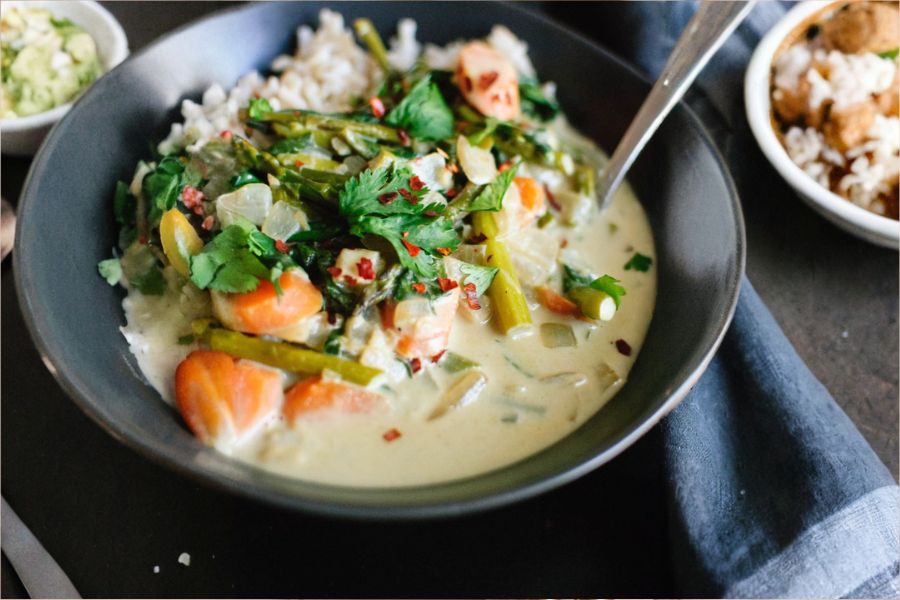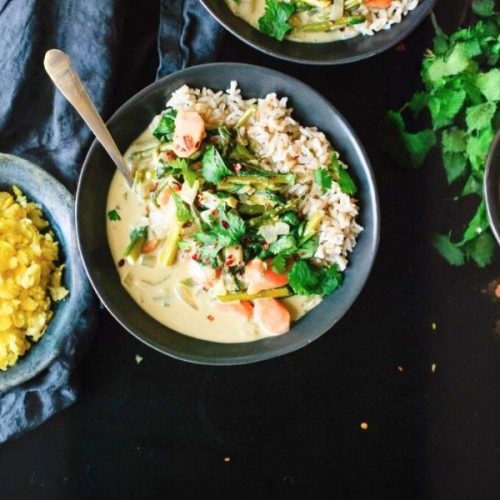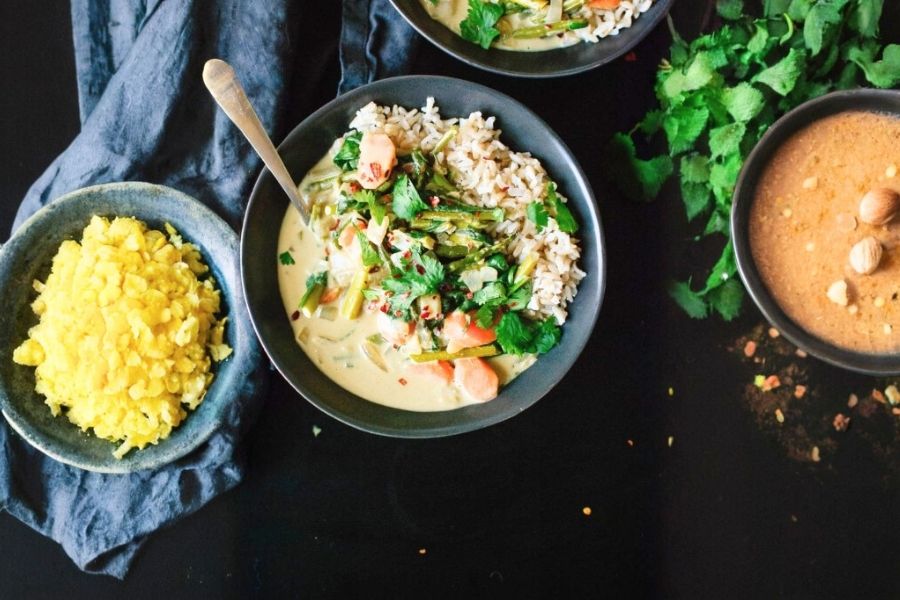This Thai Green Curry with Spring Vegetables is a vibrant, flavor-packed dish that combines the richness of coconut milk with fresh, crisp seasonal veggies.
It’s a comforting yet light vegetarian option perfect for quick weeknight dinners or weekend meal prep.
Loaded with asparagus, carrots, and spinach, this curry is packed with plant-based nutrients, including fiber for digestive health, vitamin-rich greens, and good fats from coconut milk for lasting satiety.
Using brown basmati rice makes it a wholesome, high-fiber base, while the green curry paste adds a fragrant, mildly spicy depth of flavor without overpowering the dish.
The balance of savory soy sauce, a touch of sweetness, and a squeeze of fresh lime juice creates a harmony of tastes typical of Thai cuisine.
Beyond its incredible flavor, this recipe is naturally vegetarian, adaptable for gluten-free diets, and full of plant-based protein and antioxidants, making it a well-rounded, everyday go-to dish.

Best of all, it’s ready in under 45 minutes, making healthy, home-cooked comfort food totally achievable on busy days.
Must-Have Tools for Perfect Results
Lodge 12-Inch Cast Iron Skillet
Ensures even heat distribution for sautéing onions, garlic, and veggies, preventing burning and bringing out maximum flavor. A kitchen workhorse for stir-fries, curries, and more.
OXO Good Grips Garlic Press
Effortlessly minces garlic for a more intense, even flavor release, saving you time and mess. A must-have for any home cook who loves fresh aromatics.
Zojirushi Neuro Fuzzy Rice Cooker
Perfectly cooks brown basmati rice every time, eliminating guesswork and freeing you up to focus on the curry. Ideal for meal prep and all your grain-cooking needs.
Microplane Premium Classic Zester/Grater
Makes finely grated fresh ginger in seconds, infusing the dish with bright, aromatic flavor. A versatile tool for zesting citrus and hard cheeses as well.
Vitamix 5200 Blender
Great for homemade curry pastes or quick sauce blending, ensuring a smooth, restaurant-quality finish for all your soups and curries.

Easy Green Curry with Vegetables
Equipment
- 1 Large Skillet or Sauté Pan (for curry preparation)
- 1 Large Pot (for boiling rice)
- 1 Rice Strainer/Colander (for draining rice)
- 1 Cutting Board & Chef’s Knife (for prepping vegetables)
- 1 Wooden Spoon or Spatula (for stirring)
Ingredients
- 1 cup brown basmati rice rinsed thoroughly
- 2 teaspoons coconut oil or olive oil as an alternative
- 1 small white onion finely diced
- 1 tablespoon fresh ginger peeled and minced (about 1-inch piece)
- 2 cloves garlic minced
- 1 pinch sea salt
- ½ bunch asparagus trimmed and cut into 2-inch pieces (approximately 2 cups)
- 3 medium carrots peeled and sliced diagonally into ¼-inch rounds (about 1 cup)
- 2 tablespoons Thai green curry paste vegetarian-friendly
- 1 14-ounce can full-fat coconut milk
- ½ cup water
- 1 ½ teaspoons coconut sugar or raw/turbinado/brown sugar
- 2 cups baby spinach roughly chopped
- 1 ½ teaspoons rice vinegar or freshly squeezed lime juice
- 1 ½ teaspoons reduced-sodium tamari or soy sauce
- Fresh cilantro for garnish chopped
- Red pepper flakes for garnish optional
Instructions
- Cook the Rice: Bring a large pot of water to a rolling boil. Add the rinsed brown basmati rice and cook uncovered for about 30 minutes, reducing heat slightly if needed to avoid overflowing. Once the rice is tender, drain it thoroughly, return it to the pot, cover, and let it rest for 10 minutes or more until ready to serve. This resting step allows the grains to finish steaming and stay fluffy.
- Build the Flavor Base: Heat the coconut oil in a large, deep skillet over medium heat. Once the oil is shimmering, add the diced onion, minced ginger, and garlic along with a pinch of salt. Sauté for 5–6 minutes, stirring often, until the onion turns soft and translucent and the aromatics release their fragrance.
- Sauté the Vegetables: Add the asparagus and carrots to the skillet. Cook for 3–4 minutes, stirring occasionally, until the veggies start to brighten in color but are still crisp. This step builds texture and prevents them from becoming too soft later in the cooking process.
- Infuse with Curry Paste: Sprinkle in the Thai green curry paste and stir continuously for about 2 minutes. Allow the paste to coat the vegetables and cook slightly to deepen its flavor before adding any liquids.
- Create the Curry Sauce: Pour in the coconut milk and ½ cup of water, then stir in the coconut sugar. Bring the mixture to a gentle simmer, adjusting the heat as needed to avoid boiling. Let the curry cook uncovered for 5–10 minutes, until the asparagus and carrots are tender yet still hold their shape, and the sauce has slightly thickened.
- Add the Greens and Final Seasoning: Stir the chopped spinach into the curry and cook for about 30–40 seconds, just until wilted. Remove from heat and mix in the rice vinegar (or lime juice) and tamari for a tangy, savory finish. Taste and adjust seasoning with extra salt or a pinch of red pepper flakes for mild heat if desired.
- Serve and Garnish: Spoon the warm rice into bowls and ladle the curry generously on top. Garnish each serving with freshly chopped cilantro and a light sprinkle of red pepper flakes. Serve immediately while hot.
Notes
- Seasonal Swap: If asparagus isn’t available, try snow peas, green beans, or zucchini for a similar crunch and flavor.
- Make it Gluten-Free: Use tamari instead of soy sauce to keep the dish fully gluten-free.
- Adjust Heat Level: Add extra curry paste or red pepper flakes for more spice, or reduce the paste slightly for a milder dish.
- Rice Options: Jasmine rice or quinoa can replace basmati rice for a different texture and nutritional profile.
- Meal Prep Tip: The curry tastes even better the next day as flavors meld. Store leftovers in an airtight container in the fridge for up to 3 days.
Chef’s Secrets for Perfect Curry
A great Thai green curry is all about layering flavors and balancing heat, sweetness, and acidity.
Start by sautéing your aromatics—onion, ginger, and garlic—slowly over medium heat to release their full depth without burning them.
Toasting the curry paste briefly in the pan before adding liquids is a key trick; it “wakes up” the spices and builds a richer base.
Use full-fat coconut milk for a creamier, more indulgent sauce, but don’t skip the splash of vinegar or lime juice at the end—it brightens the entire dish.
Finally, resist overcooking the vegetables. The asparagus and carrots should be tender yet still slightly crisp for a fresh, lively bite in every spoonful.
Serving Suggestions for Maximum Enjoyment
This vibrant curry pairs beautifully with fluffy brown basmati rice, but you can also try it with jasmine rice for a more traditional Thai experience.
For a low-carb option, serve it over cauliflower rice or alongside quinoa for a protein boost.
Garnish generously with fresh cilantro and a sprinkle of red pepper flakes for color and a little kick.
A side of warm naan bread or roti makes an excellent addition to scoop up every drop of the flavorful sauce.
Pair with a light cucumber salad or Thai mango salad to balance the rich coconut base and create a well-rounded, satisfying meal.
Storage Tips for Fresh Flavor
This curry keeps well, making it ideal for meal prep. Store leftovers in an airtight container in the refrigerator for up to 3 days.
The flavors tend to deepen overnight, making the dish even more delicious the next day.
If you plan to freeze it, do so without the spinach to preserve texture—add fresh spinach when reheating.
To reheat, gently warm on the stove over low heat, adding a splash of water or coconut milk to loosen the sauce.
Avoid microwaving for too long, as it can overcook the vegetables and dull their vibrant color.
Frequently Asked Questions About This Curry
1. Can I make this curry vegan?
Yes! The recipe is already vegetarian and becomes fully vegan as long as you ensure the curry paste contains no fish sauce or shrimp paste. Many store-bought brands, such as Thai Kitchen, are vegan-friendly.
2. Can I use frozen vegetables instead of fresh?
Absolutely. While fresh vegetables give the best texture, frozen asparagus, carrots, or spinach work well. Add them directly to the skillet without thawing, and slightly increase cooking time to let excess water evaporate.
3. What’s the best substitute for asparagus?
If asparagus isn’t available, snow peas, green beans, or zucchini are great alternatives. They all hold up well in curry without becoming mushy and still provide a fresh, crisp bite.
4. How do I make the curry spicier?
For more heat, stir in an extra teaspoon of curry paste or add fresh sliced chili peppers toward the end of cooking. Alternatively, a pinch of cayenne or red pepper flakes will do the trick.
5. Can I make this recipe ahead of time?
Yes, this curry is meal-prep friendly and tastes even better after a few hours as the flavors meld. Prepare it as instructed, let it cool completely, and store it in the fridge. Reheat gently before serving for best results.
This recipe has been adapted and simplified from the original version by cookieandkate. We’ve refined the steps for a smoother cooking experience and added helpful notes, nutrition insights, and essential kitchen tools to make it even easier for home cooks.

